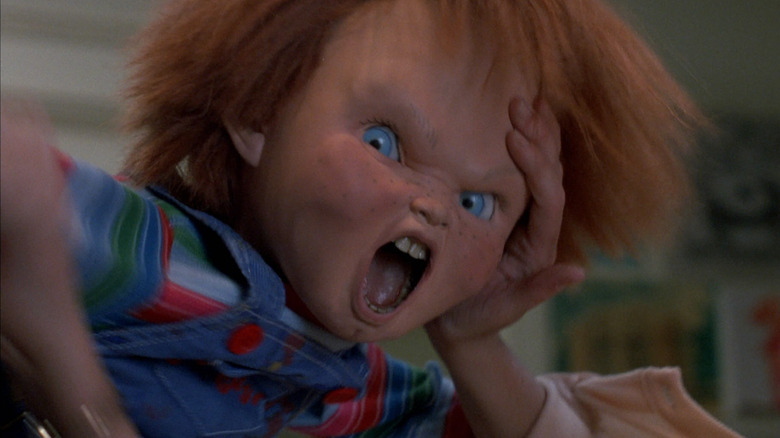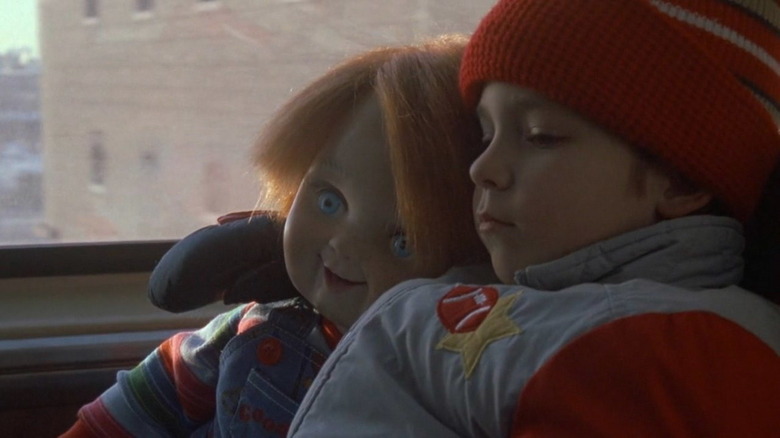The Child's Play Crew Debated Making Chucky 'More Like Jaws'
Of all the killer dolls committed to celluloid, Chucky is one of the most recognizable. Since 1988, the ginger-haired Good Guy toy has been host to the soul of serial killer Charles Lee Ray (Brad Dourif) and has since spread his mayhem across six sequels, a remake, and a successful television series about to go into its third season.
It all began with "Child's Play," first conceived by Don Mancini. The son of an ad industry veteran, Mancini aimed to satirize the stranglehold marketing had on kids. Before co-writer John Lafia and director Tom Holland touched the story, it originally lacked the serial killer or occult rituals seen in the final product. But the Chucky we know and recoil from would not only be possessed by Lee Ray and kill a man via a voodoo doll, but he would dispatch a babysitter, blow up an old acquaintance, attempt to kill a mother and two cops, and terrorize poor young Andy Barclay (Alex Vincent) — all without batteries.
Jake Rossen's oral history of the movie for Mental Floss Magazine details the struggles of working with the doll, whose behind-the-scenes difficulties ran parallel to his onscreen menace. Producer David Kirschner disagreed with how much screen time the movie monster was getting. He told Mental Floss:
I felt he kept showing too much of the doll. I wanted to be gentlemanly about it and kept whispering in his ear, and he was getting fed up with me. The doll was not working great. 'Jaws' had come out and I had seen how great that worked. You were postponing the fear. Tom wanted to show the doll. I felt it should be more like 'Jaws' or 'Alien' where you don't see anything for a long time.
Diva doll behavior
While the Chucky of 1988 was technologically a whole other animal from the pneumatically-powered shark of Steven Spielberg's '76 blockbuster "Jaws," he was just as troublesome for production. "The doll was a pain in the ass," recalled Howard Berger, one of several Chucky puppeteers on the set of "Child's Play." The doll's motion was under the supervision of special effects maestro Kevin Yagher, who would create Freddy Krueger's burn-heavy makeup on "A Nightmare on Elm Street 4: The Dream Master" the same year.
Berger further explained to Mental Floss that Chucky had poor mechanical temperament, chalking it up as the cost of forging into "brand new territory" — that is, putting a radio-controlled puppet in half of the movie. The doll simply wouldn't work the way it was supposed to, prompting numerous takes just to get a simple action completed. Alex Vincent, who plays 6-year-old Andy in the film, remembered that "having him flip his middle finger was this whole process." When he did, the servos that powered his movements screeched with every motion. Berger went on:
Everything was a hassle. I remember the scene where Chucky was in a mental hospital electrocuting a doctor. It took 27 takes to get him to press a button. Chucky's fingers would get worn out quickly. The aluminum fingers would begin to poke right through the latex skin. I had this big bag of Chucky hands and changed them three times a day.
The director couldn't contain his exasperation with the unruly puppet-actor. "It was no knock on Kevin," Tom Holland recalled, "but it was all the doll could do to take a step." Over thirty years later, the doll is still stepping mechanically in Mancini's USA and Syfy series "Chucky," the product of the showrunner's love of practical effects over CGI — a friend to the end.

